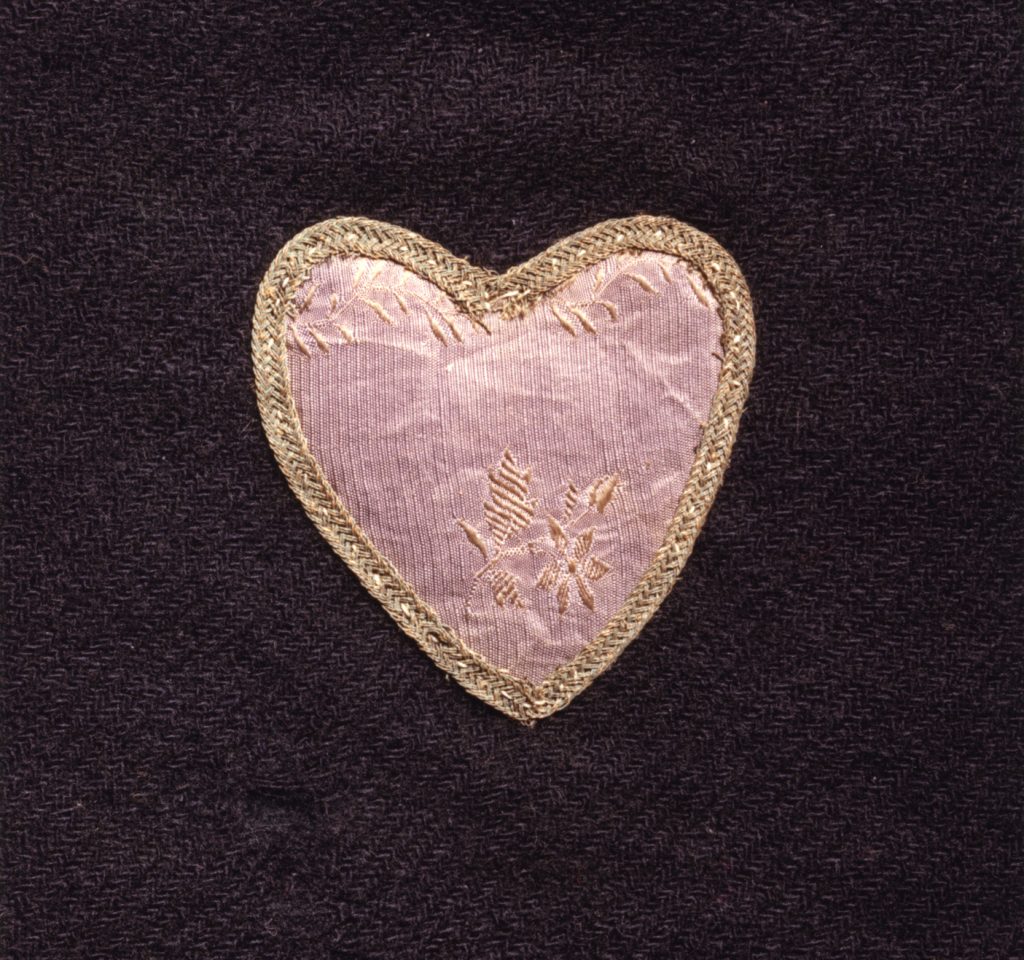
Badge of Military Merit, Collection of the American Independence Museum, Exeter, NH and the Society of the Cincinnati in the State of New Hampshire
Historical Context
George Washington created the Badge of Military Merit—the first American military decoration for enlisted men—on August 7, 1782. Soldiers were honored with the award for “instances of unusual gallantry…extraordinary fidelity and essential service.” This lesson invites students to consider the significance of the badge and other awards given for meritorious conduct in the war, its 1932 revival as the modern Purple Heart and George Washington’s conviction that in the new American republic, the “road to glory” was open to all.
Suggested Grade Level
Middle and High School
Recommended Time Frame
One fifty-minute session
Objectives and Essential Questions
Students will:
- explore the history of the Badge of Military Merit, and
- learn how this award was a departure from military tradition by comparing the Badge of Military Merit to medals presented by Congress.
Materials and Resources
(in order of appearance)
- Badge of Military Merit
- George Washington, General Orders, August 7, 1782
- Anthony Wayne at Stony Point, William Washington at the Cowpens and Daniel Morgan at the Cowpens medals
Background Knowledge
Students should have a basic understanding of the modern Purple Heart military decoration including its history and who the medal is awarded to today.
Sequence and Procedure
General George Washington directed that a soldier honored with the Badge of Military Merit “shall be permitted to wear on his facings over the left breast, the figure of a heart in purple cloth, or silk, edged with narrow lace or binding.” Washington created the award—the first American military decoration for enlisted men—on August 7, 1782 to honor “instances of unusual gallantry…extraordinary fidelity and essential service.” He further ordered that “those gallant men who are thus designated will on all occasions be treated with particular confidence and consideration.” Veterans may have worn this badge of honor on their civilian coats after the war. The army’s Book of Merit, recording the names of the Badge’s recipients has been lost, possibly in the fire that consumed the War Department in 1800. Only two reputed examples of the Badge are known to have survived, one of which is Collection of the American Independence Museum in Exeter, New Hampshire. The award was revived in 1932, on the bicentennial of George Washington’s birth. The Purple Heart, as it has come to be known, is now awarded to soldiers wounded during combat, with the modern medal bearing Washington’s portrait.
1. Ask students to examine the American Independence Museum’s Badge of Military Merit using the See, Think, Wonder strategy focusing on why General Washington had the award made of cloth instead of metal, and what is symbolic about its shape.
2. Once students have finished, have them read George Washington’s August 7, 1782 General Orders creating the Badge of Military Merit and answer the following questions.
- In addition to the Badge of Military Merit, General Washington also created the Honorary Badge of Distinction for length of service. Why would General Washington want to recognize the amount of time soldiers had served in the army? Does the description of this badge with parallel chevrons of cloth resemble any modern rank insignia seen on U.S. Army uniforms today?
- Why do you think General Washington departed from the military tradition to honor officers to create the Badge of Military Merit as an award for ordinary soldiers? What did this award indicate about the type of country General Washington envisioned?
During the Revolutionary era, medals were the most common way for governments and private groups to honor individuals and mark important events. In 1776 the Continental Congress awarded the first medal of the Revolutionary War, presented to George Washington to commemorate the Siege of Boston that forced the British evacuation of the city. Congress authorized at least a dozen medals during the founding era to express national appreciation for individual heroism and major victories of the Revolution. Copies of these medals were made during the eighteenth century and in the years since, communicating the nation’s achievements and ideals to a broader American public. The original gold and silver medals are rare—the examples from the Society of the Cincinnati’s museum collection are restrike copies.
3. Share examples of the congressional medals awarded by the Continental Congress with students commemorating the actions of Anthony Wayne at the Battle of Stony Point and William Washington and Daniel Morgan at the Battle of Cowpens. Independently or in small groups, ask students again to utilize the See, Think, Wonder model to analyze the medals.
Assessment and Demonstration of Student Knowledge
Ask students to write a blog post comparing the congressional medals to the Badge of Military Merit that informs the reader and provokes reflection about the character of awards and decorations. Have students think about the similarities between the two types of awards as well as the differences—while both awards signify brave service to a virtuous republic, there are notable differences in their construction, imagery and symbolism, as well as who awarded them and who was eligible to receive them.
Extension
Ask students to research a medal awarded by the U.S. military today, consider how it compares to awards given during the American Revolution, and incorporate this modern example into their blog post.
Revolutionary Achievements Category
Our Highest Ideals
Exploring the Revolution Category
The Revolutionary War, The Legacy of the Revolution
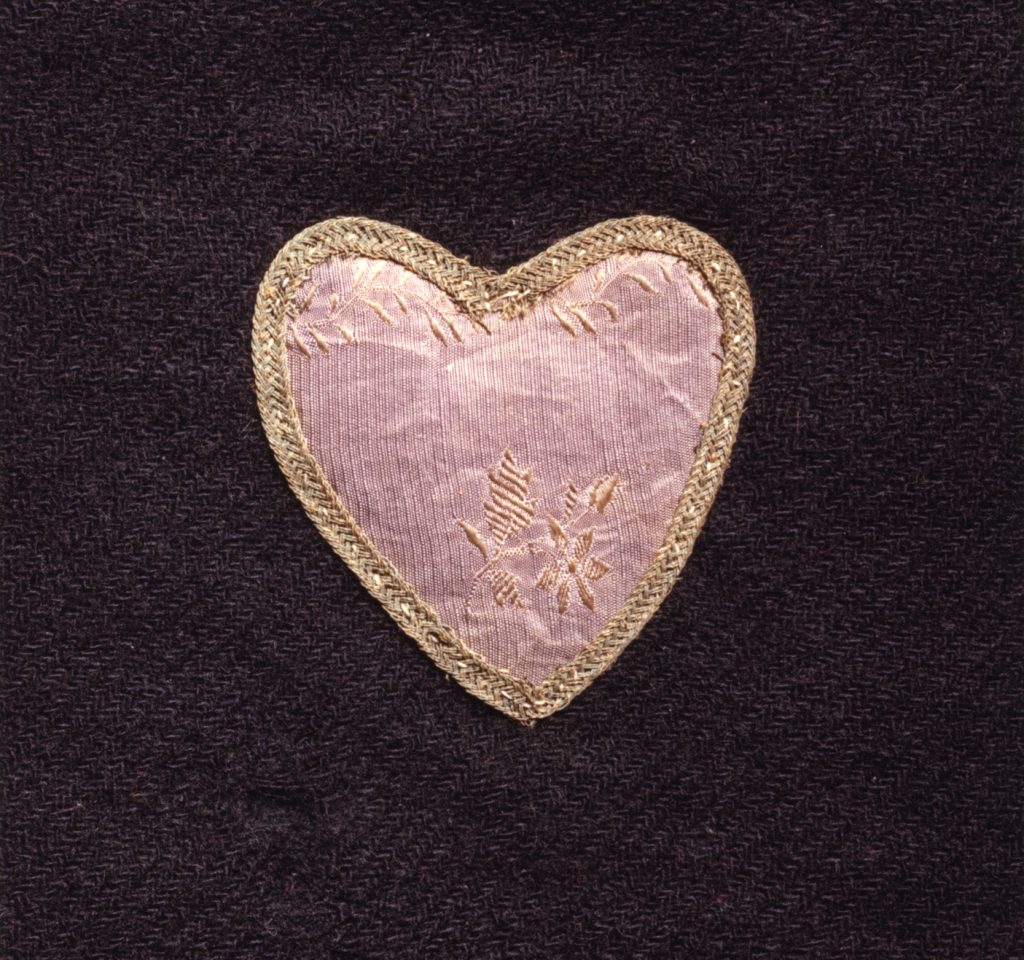
Badge of Military Merit
ca. 1782-1783Collection of the American Independence Museum, Exeter, NH and the Society of the Cincinnati in the State of New Hampshire. Gift of William L. Willey.
George Washington created the Badge of Military Merit—the first American military decoration for enlisted men—on August 7, 1782. The award recognized distinguished conduct and was intended to encourage “virtuous ambition” and “every species of Military merit.” Soldiers honored with the award “shall be permitted to wear on his facings over the left breast, the figure of a heart in purple cloth, or silk, edged with narrow lace or binding.” Only two reputed examples are known, of which this is one. The decoration fell out of use after the Revolutionary War but was revived in 1932 as the modern Purple Heart.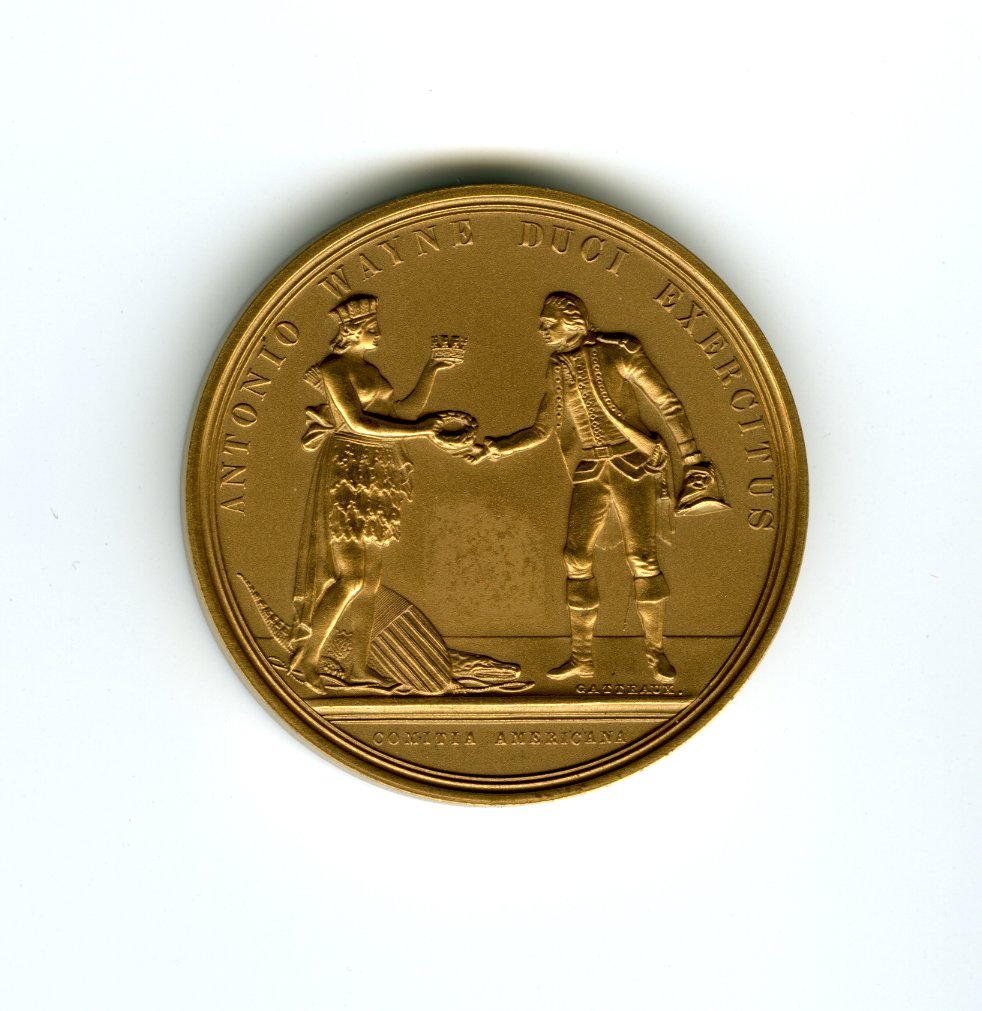
Anthony Wayne at Stony Point
Nicolas Marie Gatteaux, engraver
twentieth centuryGift of Captain and Mrs. William Jeffries Chewning, Society of the Cincinnati in the State of Virginia, 1963
The obverse of the medal features a scene of two figures. America, personified as a Native American queen, wearing a cap and a skirt of feathers and having at her feet a bow, an alligator, and the American shield, presents a slightly bowing General Wayne with a laurel wreath and a mural crown. An inscription around the top and along the bottom reads "ANTONIO WAYNE DUCI EXERCITUS / COMITIA AMERICANA" (The American Congress to General Anthony Wayne). Underneath Wayne's feet is the identification of the engraver "GATTEAUX." The reverse features a view of the assault on Stony Point, including both sides of the Hudson River, with Point Fort in the distance and a battery and troops in the foreground.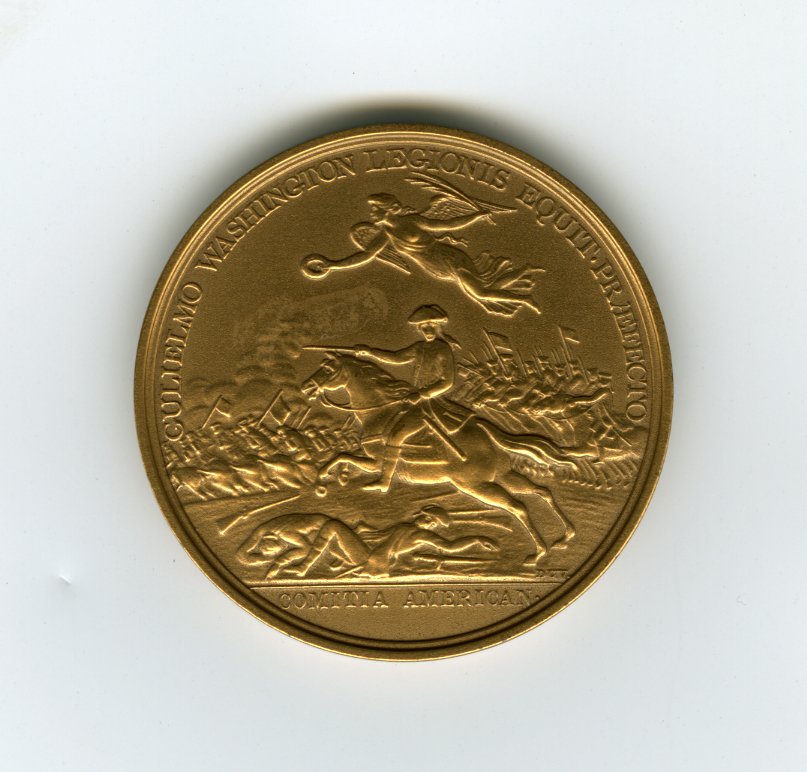
William Washington at the Cowpens
Pierre-Simon-Benjamin Duvivier, engraver
twentieth centuryGift of Captain and Mrs. William Jeffries Chewning, Society of the Cincinnati in the State of Virginia, 1963
William Washington was an officer in the Virginia Continental Line and the Continental Dragoons during the Revolutionary War and original member of the Society of the Cincinnati of the State of South Carolina. The obverse features a scene of William Washington on horseback with a sword in his right hand pointed forward, leading the American troops in the background. A winged figure of Victory hovers over him, holding a laurel wreath in her right hand and a palm branch in her left hand.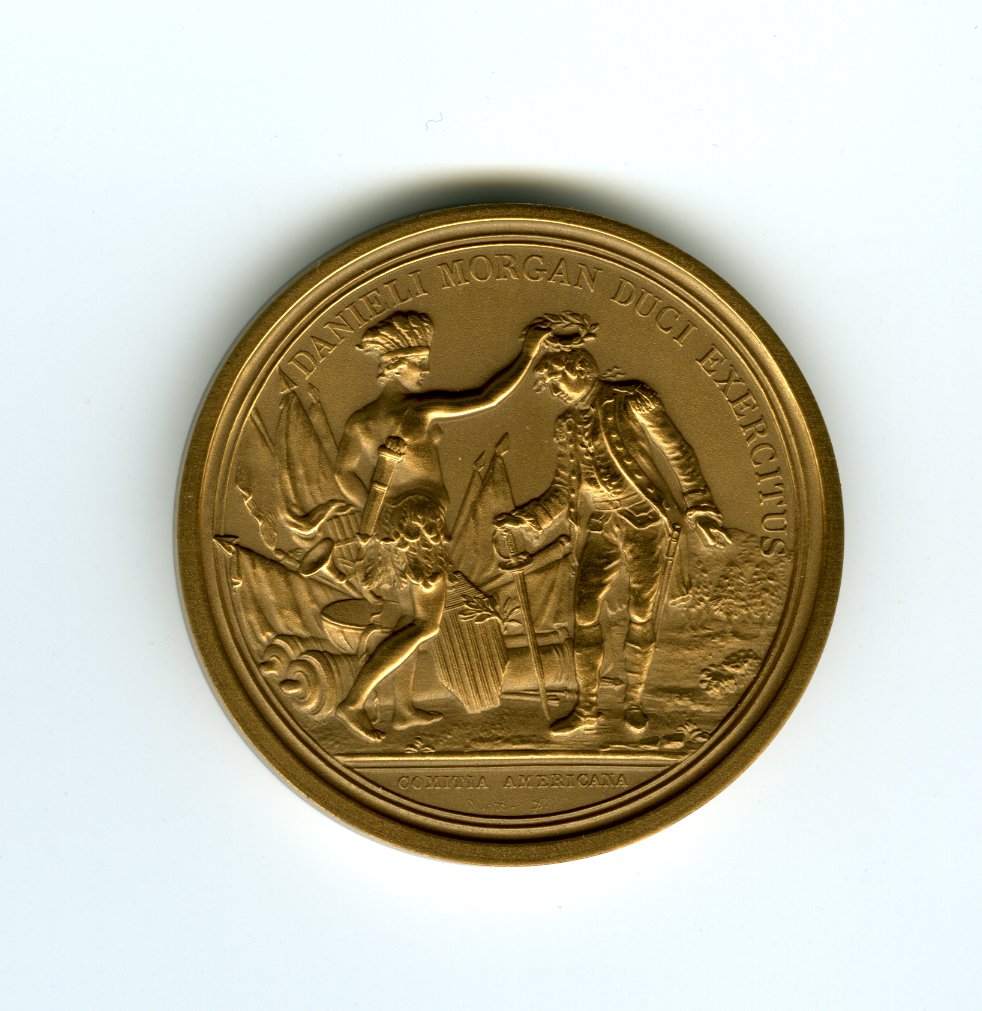
Daniel Morgan at the Cowpens
Augustin Dupre, engraver
twentieth centuryGift of Captain and Mrs. William Jeffries Chewning, Society of the Cincinnati in the State of Virginia, 1963
Daniel Morgan was a brigadier general in the Continental Army during the Revolutionary War and original member of the Society of the Cincinnati in the State of Virginia. The medal features two full-length figures dominating a scene in the center. An allegorical figure of America as a Native American princess, wearing a headress, skirt, and quiver, stands at the left and places a laurel wreath on the head of Daniel Morgan, who bows slightly. Morgan wears a military uniform and holds in his proper right hand a sword pointed downward with its tip on the ground. The background is filled with a trophy of arms featuring flags, cannons and a shield.